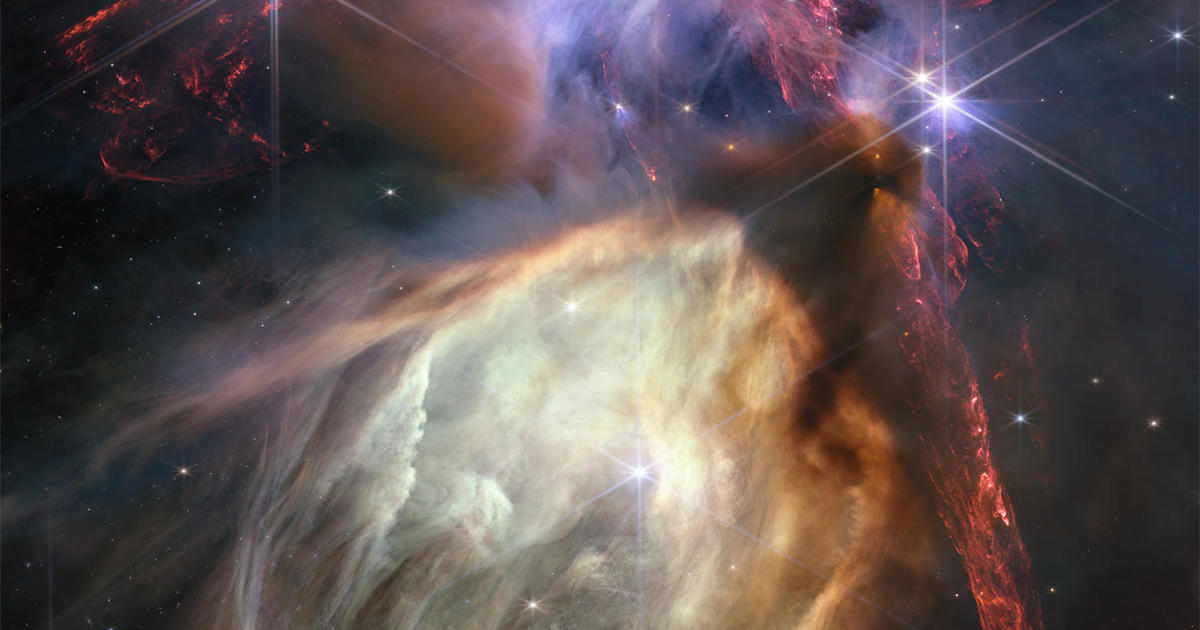Commencing the one-year commemoration of scientific observations with the James Webb Space Telescope, a $10 billion endeavor, NASA unveiled a breathtaking new image on Wednesday showcasing the nearest region to Earth where stars are forming. This vibrant and chaotic tapestry of swirling gas is adorned with sun-like stars.
The Rho Ophiuchi cloud complex, a stellar nursery, boasts approximately 50 young stars, all similar in size to our own sun or even smaller.
“The dark regions represent the densest areas, where thick dust cocoons are still forming protostars,” explained NASA in their description of the photo, which was captured by Webb’s Near Infrared Camera (NIRCam).
Breathtakingly, the image reveals immense bipolar jets of molecular hydrogen, portrayed in red, dominating the scene. These jets appear horizontally across the upper third and vertically on the right side of the image. They occur when a star emerges from its birth envelope of cosmic dust, propelling a pair of opposing jets into space.
Klaus Pontoppidan, the Webb project scientist, stated, “This image allows us to witness a brief period in the life cycle of a star with newfound clarity. Our own sun experienced a similar phase in the past, and now we possess the technology to witness the beginning of another star’s tale.”
NASA Administrator Bill Nelson remarked, “In just one year, the James Webb Space Telescope has revolutionized humanity’s perception of the cosmos. It has delved into dust clouds and glimpsed light from the farthest corners of the universe for the very first time. Each new image brings forth a new discovery.”
The James Webb Space Telescope was launched atop an Ariane 5 rocket on Christmas Day, 2021, from the European Space Agency’s Kourou, French Guiana, launch site. After a month-long journey, the telescope reached its designated location: Lagrange Point 2, situated a million miles from Earth on the far side of the moon’s orbit, where it currently orbits the sun in perfect harmony with Earth, providing the cold and dark conditions necessary for a successful mission.
Webb, recognized as the most intricate civilian scientific instrument ever constructed, was folded to fit inside the Ariane 5’s nose cone. Along the way to Lagrange Point 2, scientists and engineers held their breath as the telescope extended a complex sunshade the size of a tennis court to cool the observatory to a temperature within 50 degrees of absolute zero.
Following this, the telescope’s six hexagonal side segments, composing a primary mirror measuring 21.3 feet in width, were deployed, and the optical system was meticulously aligned to produce impeccably sharp images.
The telescope, equipped with four instruments, is optimized to capture light emitted by the first stars and galaxies that emerged following the Big Bang’s cosmic birth. This light has been stretched into the infrared region of the spectrum due to the expansion of space over the course of 13.8 billion years.
Such light is invisible to current ground-based telescopes, including the renowned Hubble, designed primarily to study visible and near-infrared wavelengths. Nonetheless, Hubble has detected galaxies dating back to nearly half a billion years after the Big Bang, a discovery that surpassed astronomers’ expectations.
The Webb telescope aims to surpass this milestone, provided everything goes according to plan. Given the telescope’s complexity, it caused considerable apprehension within the astronomical community. However, after six and a half months from launch, Webb was fully calibrated and operating as intended. NASA released five initial images on July 12, 2022, clearly demonstrating the extraordinary capabilities of this historically expensive scientific instrument.
During its first year of operation, the Webb telescope has explored deeper into space and further back in time than ever before. It has already detected at least one galaxy that began shining just 390 million years after the Big Bang, setting a record that will likely be surpassed soon as several other candidates await confirmation.
Webb has also identified the earliest known supermassive black hole, powering a quasar that blazed into existence 570 million years after the birth of the universe. These discoveries have prompted researchers to revisit their understanding of how galaxies and supermass
Denial of responsibility! VigourTimes is an automatic aggregator of Global media. In each content, the hyperlink to the primary source is specified. All trademarks belong to their rightful owners, and all materials to their authors. For any complaint, please reach us at – [email protected]. We will take necessary action within 24 hours.




